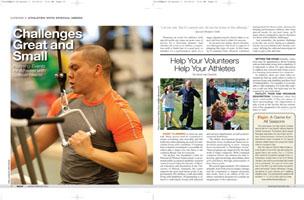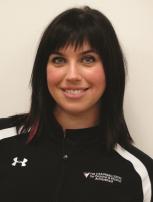
"Let me win. But if I cannot win, let me be brave in the attempt."
-Special Olympics Oath
Planning an event for athletes with special needs can cause an acute case of nerves for a first-time planner. And whether the event is an athletic competition with a finish line or a goal post, or whether it's a performance sport on a stage, planners need to know what to expect and how best to plan for success.
In our next two issues, Sports Destination Management will focus on aspects of planning this type of event. In this issue, we'll examine first, effective volunteer management for these events, and second, helping performance athletes who have special needs. In our next issue, we'll learn about competitive sports facilities for those with mobility challenges.
Just remember: the greatest challenge is not the one you're facing as a planner, but the one your athletes have already overcome: defying the odds and stereotypes in order to get to the start line.


Help your volunteers help your athletes
by Kirsti Van Dornick
Event planning is never an easy task. Many factors must be considered to ensure everything runs smoothly, and this holds true when planning an event for individuals living with a disability. Everything from volunteer recruitment to accessible facilities play a major role, but there is one common thread: Fun for everyone.
Our facility, The Steadward Centre for Personal & Physical Achievement, is an internationally acclaimed disability research centre housed within the Faculty of Physical Education and Recreation at the University of Alberta. Annually, the centre supports the sport and fitness goals of approximately 600 children, youth and adults living with disabilities. Programming is offered to individuals living with physical and sensory impairments, as well as developmental disabilities.
The athlete development programs offered here focus on physical fitness for individuals participating in sport ranging from recreational to Paralympic levels. These programs are supported by the hard work of many volunteers. With continued volunteer efforts, the athletes are able to develop, gain knowledge and enhance their self-confidence through achievement of their fitness goals.
We recruit approximately 100 volunteers annually from both post-secondary settings and the community to support programs and events. Here is an outline of the volunteer orientation program we consider an integral part of the experience:
Setting the Stage: Initially, volunteers may be apprehensive about working with an individual living with a disability. It is important to allow for open discussion to address any concerns and create a positive learning environment for volunteers.
In addition, there are often other assumptions that are made when it comes to persons living with disability and their level of independence. For example, it is acceptable to offer assistance if it looks like a person could use help, but help may not be required by that individual.
Facility Tour and Program Description: Volunteers often feel more comfortable if they are aware of their surroundings. An opportunity to take a look at the facility and an orientation of the equipment to be used is a good place to start.
|
Photo courtesy of Zoltan Kenwell |
Ensuring the volunteers are familiar with the program or event being held is important. If spectators or athletes have questions and volunteers are the first point of contact, it is critical the volunteers know how to answer these questions, and to know who to refer to if they don't know an answer. Common questions will include the location of accessible rest rooms and access routes to enter the facility. Organizers should also ensure that volunteers are conscious of the language to be used at the event or within the program – whether it be the name of a particular exercise, name of the equipment or on a larger, more philosophical scale, person-first language (for example, "person with a disability" versus "disabled person").
Introduction to Athletes: Depending on their role at the event, volunteers may benefit from a session on working with an individual who has a disability. Whether the focus is on the best way to communicate, providing feedback on a skill or motivating athletes, providing volunteers with these tools is invaluable.
When volunteers are involved in the program or event, they will gain further insight into methods that work or don't work – and this is a good time to have a de-brief session to develop strategies to continue to accommodate all individuals at future events.
The ultimate goal is for the athlete to get the most out of his or her experience. With support from the organizers and keen volunteers, all participants should feel like they had a rewarding experience and will look forward to attending such events in the future.
Setting the stage for successful performances
by Zoey Robinson-Budreski
Performance sports, including competitive dance, gymnastics and cheer, are an emerging arena when it comes to athletes with special needs. Drama, music, acting and other performing arts are also an area where these children, young adults and even adults can help erase the barriers that once separated them from their peers.
|
Photos courtesy of Baltimore City Special Olympics |
Special Olympics, with their can-do emphasis, have raised awareness of the abilities and strengths, as well as the unconquerable spirit, of individuals with developmental disabilities. Now performance sports and the performing arts are doing their part. How? By letting people do everything they can, and more.
Our facility, the B-More Abilities Special Arts Center in Baltimore, Maryland, has the same equipment you might find in a typical dance studio: a stage, curtains, mirrors and more. And at facilities that teach other performance sports like cheer and gymnastics, you'll probably find a gym, mats and similar equipment. What's different with performance facilities for individuals with special needs is that you might also find ramps to help those who have mobility issues and hand rails to assist with balance, as well as other adaptive equipment.
Being responsive to a clientele with special needs means being keenly aware of what affects our participant. Those with sensory disabilities, for example, are often bothered by bright lights or strobes, and as a result, we use softer, more even lighting as well as softer music. We use picture boards to communicate back and forth with our non-verbal students.
Facilities can help out your participants. Our stage has different types of footing so that performers can feel where they are by the texture on the floor. As a dance company that accommodates performers in wheelchairs, we have a lot of unique adaptive equipment. For example, we have a large, supportive beam in the middle of our stage that has netting a performer can sit in. This gives them the freedom to move around the stage without their wheelchair.
 We're far from the only ones who tailor their programs. In a cheer program where participants are developmentally disabled, instructors will likely emphasize teamwork and movement as well as spirit and excitement in their squads, rather than the complex aerial maneuvers commonly seen in competitive cheer.
We're far from the only ones who tailor their programs. In a cheer program where participants are developmentally disabled, instructors will likely emphasize teamwork and movement as well as spirit and excitement in their squads, rather than the complex aerial maneuvers commonly seen in competitive cheer.
It's certainly not news for me to say that there's no 'mold' for special needs performers, particularly in an arena where challenges may range from developmental to sensory to physical, or to various combinations of those and others. Therefore, you just have to be ready to explore participants' needs, find out what they're comfortable with, and help them push the envelope when they're ready.
Be aware that these kids are like all others: they can learn new things and gain new confidence by stepping outside their comfort zone. We also manage Project SOAR, which addresses age 15 and up, taking them on adventures like zip-lining and high ropes and in the future, rafting. We have safeguards and special equipment in place, and all activity is carefully supervised. But at the end of the day, the kids are high-fiving each other and laughing and smiling -- exactly like others their age.
More confidence, new skills and personal growth. Everyone wants that for their children. In performing sports, we like to think of it as taking the 'dis' out of disability.




